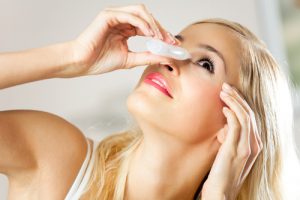As the temperatures drop, do you find yourself spending more time in front of your TV? It’s football season, so it’s only natural to want to root on the Vikings!
But is there a limit to how much our eyes can take? Keep reading to learn how much screen time is too much and what you can do to keep your eyes healthy!
Too much screen time can lead to computer vision syndrome
If you haven’t heard of computer vision syndrome, it’s also known as digital eye strain. Digital eye strain is a group of eye conditions that can occur because of prolonged computer and device use.
On average, workers in America spend seven hours per day on the computer. After a short period of time, this starts to take a toll on your eyes.
Part of the problem is most people at work have double monitors. When you’re looking at two monitors for over seven hours a day, your eyes will get tired.
The more you look at screens, the more likely you are to experience digital eye strain. Common symptoms include dry eye, eye pain, discomfort, and blurry vision. It only gets worse as you continue looking at screens.
Increased screen time means more dry eye and less blinking
Another side effect with digital eye strain is you blink less. What’s the big deal? It’s just blinking, right? Not exactly. Not blinking is going to start you down the path towards dry eye syndrome.
This is one of the most common side effects for people that stare at screens and devices all day long. If your eyes feel gritty, look bloodshot, or water uncontrollably, you may have dry eyes.
Thankfully, there are some things you can do about a reduced blink rate. First of all, practice the 20-20-20 rule.
With this rule, every 20 minutes, take a break to look at something (not a screen!) that’s at least 20 feet away for at least 20 seconds.
Regular breaks away from the screens are the very least you can do to help your eyes recover during a long workday.
Another thing you can do? Try to blink more. Sounds stupid, but when you’re looking at a screen, it causes your blink rate to drop to half of what it should be.
If you know you’ll be looking at a screen for a long time, have some artificial tears on hand as well. Use them when your eyes start feeling dry or itchy.
The last thing you want to do is scratch or irritate them while they are uncomfortable!
Are the effects of computer vision syndrome permanent?
If you find yourself with computer vision syndrome, there’s no need to panic! The effects are not permanent, as long as you take some steps to correct the problem.
In some cases, this may mean having a special pair of glasses prescribed only for computer work. These glasses will often have a tint or coating on them that makes working in front of a computer easier.
You may also need to look into how you are sitting at your computer. For many people, working in front of a computer is a problem because of the glare coming off the screen.
If this is part of the problem, you can get special glare-reducing filters for your computer. These filters help reduce how much glare is coming off your computer screen or reflected off it.
If it’s not an issue with glare, you may want to see if the distance of your computer is playing a part as well. Your computer shouldn’t be too close to your face.
Instead, the computer should be about 15 to 20 degrees below eye level. This is about 20 to 28 inches from your eyes.
What can I do to help my eyes?
Even if you don’t have computer vision syndrome or digital strain, there are things you can do to help your eyes.
Eat foods that keep your eyes hydrated
Drinking water is an important part of hydration, but did you know that the food you eat affects your eyes too? Aim to eat foods like:
● Kale, spinach, and collard greens. These dark leafy greens have lots of Vitamin C and E, as well as lutein and zeaxanthin. Eating more of these lowers your risk of age-related macular degeneration and cataracts.
● Fatty fishes like salmon, tuna, and trout. Seafood has high amounts of Omega-3 fatty acids in them. This can help reduce dry eye and protect you from AMD and glaucoma.
● Cucumber, melons, celery, tomatoes, radishes, green peppers, watermelon, and strawberries. These fruits and vegetables all have very high water content, which is key if you want to stay hydrated.
Want to incorporate more hydrating foods into your diet?
Consider a melon, strawberry smoothie for a healthy and hydrating kick. Or, you could put together a salad with cucumbers, tomatoes, radishes, and green peppers. It goes to show, you can eat your way to hydration too!
Wondering if you could be suffering from the effects of computer vision syndrome? Struggling with the debilitating symptoms of dry eye syndrome?
We can help! Schedule an appointment at Minnesota Eye Consultants in Minneapolis, MN today!









